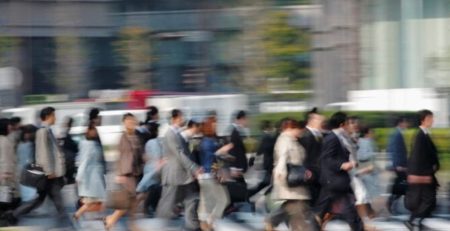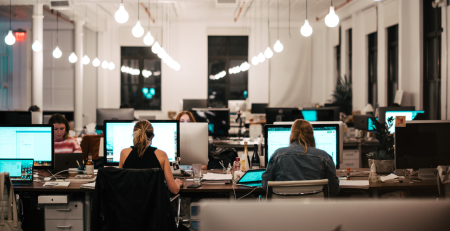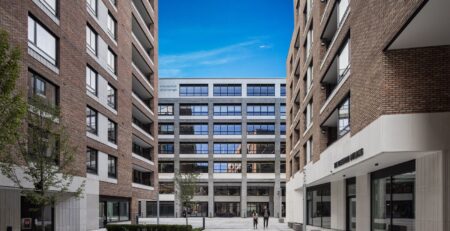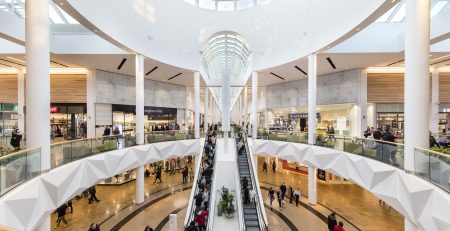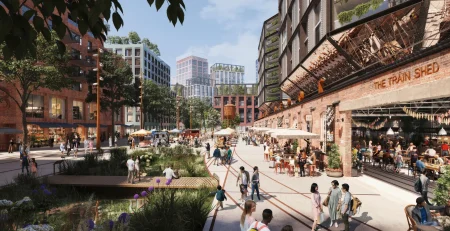What was The Buzz in November?
Our monthly roundup of real estate industry news.
Here are a few of the stories that caught our attention in November. From London’s best new home, design of the future workplace, and the impact of global warming and hybrid working on the office industry, we’re taking a glimpse into what the future of the real estate industry looks like this month.
“Extraordinary ordinary house” in London named UK’s best new home
The polycarbonate-lined Green House that architecture studio Hayhurst & Co slotted into a tight site in London has been named the RIBA‘s House of the Year for 2023. Replacing an existing home in an alleyway in Tottenham, the plant and light-filled residence is modelled on a riad – a type of traditional Moroccan house built around a central courtyard. It was hailed by the jury of this year’s RIBA House of the Year prize as “a true oasis within the city”.
Milne added that Green House was also chosen as the 2023 winner for the clients’ and studio’s joint ambition to “deliver a truly sustainable home”, which “is evident in all of the design decisions and detailing” despite a tight budget.
“Nowhere do you feel the site or budget was restricted,” she explained. “It feels both luxurious, homely, deeply private and relaxing. It’s an extraordinary ordinary house and a remarkable collaboration.” Read more.
Can Instagrammable design lure young workers back to the office?
More and more employers vying for young talent are creating The Envy Office — when companies try to combine the comforts of a living room and the glamour of a vacation. These spaces — often characterised by colourful walls, upholstered furniture and carefully curated coffee table books — aim to lure workers in with plenty of opportunities to fill their social feeds with photos taken at the workplace. “It’s taking cues from home, from hospitality, from Pinterest,” said Jordan Goldstein, a co-managing principal at one of the world’s largest architecture firms, Gensler where clients have lately been asking for greenery and soft seating. He cited, as an example, the new headquarters of Marriott, which Gensler redesigned to incorporate banquettes, library nooks and a tree growing through the middle of the lobby.
Gensler has also recently redone offices for Barclays, Pinterest and LinkedIn in this style. That Instagrammability isn’t accidental. Brooke Erin Duffy, an associate professor of communication at Cornell University, argues that employers are using social media aesthetics in the same way they’re deploying traditional perks like cold brew, or less traditional ones like the Lizzo concert Google put on for its workers. It’s all corporate image making. Companies now want their office design to be visible not just to employees, but also to everyone on social media, which Ms. Duffy said was about “retaining employees by hyping this fun, enjoyable, hyper-social workplace.” Read more.
Downsizing for the Greater Good
EY is considering closing one of its major HQs because of remote working and climate change. The Big Four accounting firm is reportedly looking to vacate its massive 10-story building near London Bridge that houses 9,000 employees and move to an environmentally friendly building to help towards its goal of being carbon neutral by 2025.
EY moved to a hybrid model in the U.K. in 2021 which gave staff the freedom to work remotely at least two days a week, with an expectation that they would work at client sites or in the office the rest of the time. A representative for EY told Fortune: “As a growing business with over 20 offices across the U.K., we continually review our real estate footprint.” Read more.
Hybrid work continues to grow among global employers
Hybrid work continues to grow among global employers, says the latest report by JLL. With most workers back in the office globally, reconciling individual and collective needs will be a top priority for creating a positive hybrid employee experience. The report explores employers’ and employees’ new expectations in today’s hybrid environment, uncovering best practices to attract employees to the office and maintain the flexibility offered by remote work.
“The office has always been, and will continue to be, central to work experience and culture,” said Neil Murray, CEO, Work Dynamics for JLL. “As more workers return to the office several days a week, we’re continuing to learn about the shifting preferences for ways of working and how we can better deploy technology and flexible arrangements to meet these expectations. Ultimately, our research finds that the majority of global workers continue to crave a destination for human connection, so creating dynamic spaces that satisfy a mix of collaborative and focused work needs will ultimately be the most effective strategy to enticing employees to the office on a regular basis.” Read more.
What does WeWork’s bankruptcy mean for flexible working?
WeWork certainly succeeded in bringing flexible office space to the forefront but there was just one problem: the company could not make it pay, reports Financial Times. WeWork’s slide into US bankruptcy in November, under the weight of more than $13bn in office lease obligations, has cast a shadow over flexible workspace providers and sharpened fears about financial distress for office landlords struggling with the move to working from home.
But Mark Dixon, chief executive of IWG, argues “the travails and tribulations with WeWork” have been a “sideshow” to a huge shift in the office market. “The body blow is technology, not WeWork . . . technology is changing how people work,” Dixon said. Flexible office brands hope that companies looking to save money on large static offices will see flexible space — ranging from desks by the hour to full floors with custom designs — as a substitute, despite the trouble for the sector’s best-known name. “The great irony of WeWork’s bankruptcy is that it comes at the exact moment when the flex industry in general has been seeing record performance,” said Jamie Hodari, chief executive of Industrious. He said many companies were moving out of “oversized-headquarter space . . . into more flexible space at a more modest size”. “WeWork’s bankruptcy has been less about the lack of demand than the specifics of their business model.” Read more.
Vision for ‘pedestrian friendly’ Ludgate Circus revealed in £80m Fleet St revamp
Plans to make Ludgate Circus, one of central London’s most intimidating junctions, far more friendly for pedestrians were unveiled today as part of an £80 million blueprint for transforming the area around Fleet Street.
The proposals from the Fleet Street Quarter Business Improvement District, would mirror the changes at Oxford Circus made in 2009, with diagonal crossings, the removal of clutter such as railings and wider pedestrian walkways. A strategy document from the business group drawn up by architects Gensler says Ludgate Circus, currently a daunting expanse of tarmac with heavy traffic and fast moving packs of cyclists, could be transformed into a “vibrant destination.” The 10 year plan aims to double the number of safe cycle routes and add 3,000 sq m of pedestrian space in the western City. Read more.




